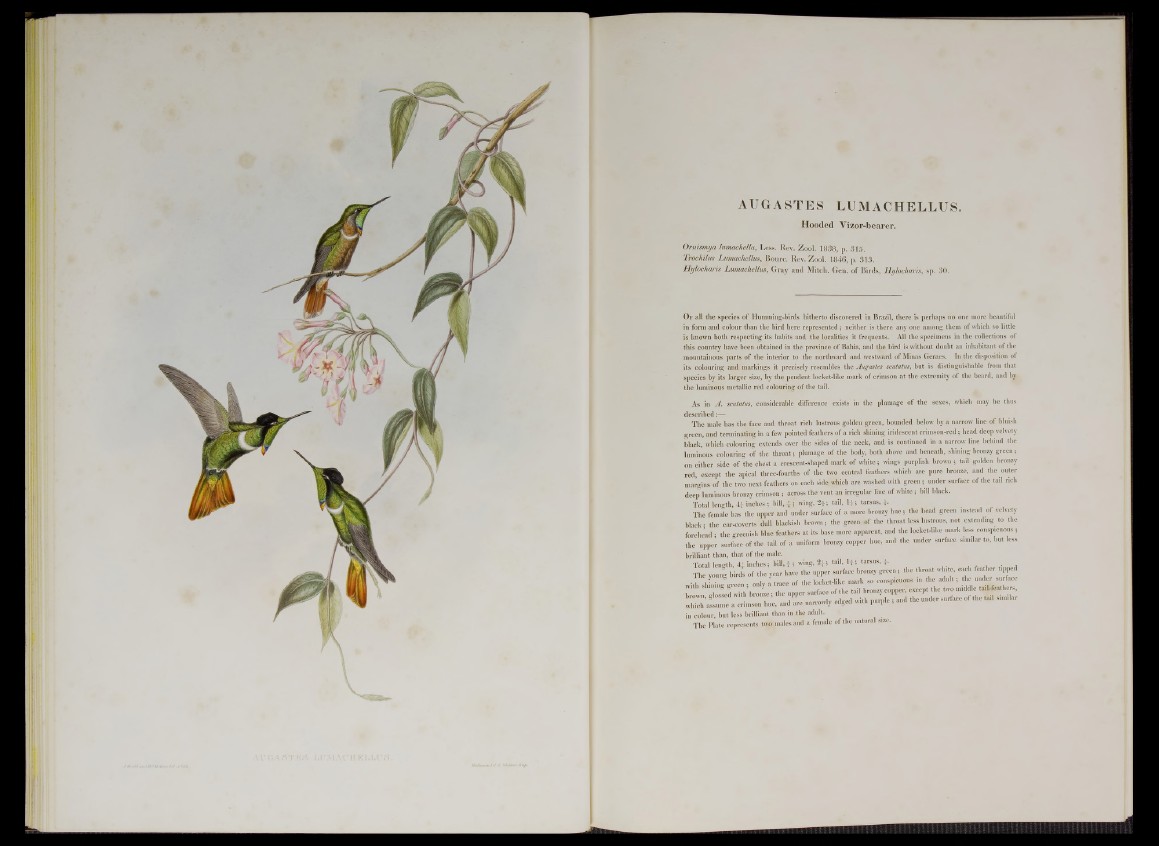
AUGASTES LUMACHELLUS.
Hooded Yizor-bearer.
Ornismya lumachella, Less. Rev. Zool. 1838, p. 315.
Trocliilus Lumachellus, Bourc. Rev. Zool. 1846, p. 313.
Hylocharis Lumachellus, Gray and Mitch. Gen. o f Birds, Hylocharis, sp. 30.
O f all the species of Humming-birds hitherto discovered in Brazil, there is perhaps no one more beautiful
in form and colour than the bird here represented; neither is there any one among them of which so little
is known both respecting its habits and the localities it frequents. All the specimens in the collections of
this country have been obtained in the province of Bahia, and the bird is without doubt an inhabitant of the
mouutainous parts of the interior to the northward and westward of Minas Geraes. In the disposition of
its colouring and markings it precisely resembles the Augastes scutatus, hut is distinguishable from that
species by its larger size, by the pendent locket-like mark of crimson at the extremity of the beard, and by
the luminous metallic red colouring of the tail.
As in A . scutatus, considerable difference exists in the plumage of the sexes, which may be thus
described:—
The male has the face and throat rich lustrous golden green, bounded below by a narrow line of bluish
green, and terminating in a few pointed feathers of a rich shining iridescent crimson-red; head deep velvety
black, which colouring extends over the sides of the neck, and is continued in a narrow line behind the
luminous colouring of the throat; plumage of the body, both above and beneath, shining bronzy green;
on either side of the chest a crescent-shaped mark of white; wings purplish brown; tail golden bronzy
red, except the apical three-fourths of the two central feathers which are pure bronze, and the outer
margins of the two next feathers on each side which are washed with green; under surface of the tail rich
deep luminous bronzy crimson ; across the vent an irregular line of white ; bill black.
Total length, 4* inches ; bill, ¿ ; wing, 2 f; tail, H ; tarsus, | .
The female has the upper and under surface of a more bronzy hue; the head green instead of velvety
black- the ear-coverts dull blackish brown; the green of the throat less lustrous, not extending to the
forehead • the greenish blue feathers at its base more apparent, and the locket-like mark less conspicuous ;
the upper surface of the tail of a uniform bronzy copper hue, and the under surface similar to, but less
brilliant than, that of the male.
Total length, 4A inches; bill, M wing, 2±; tail, I f ; tarsus,
The young birds of the year have the upper surface bronzy greeu; the throat white each feather tipped
. . . . . i 1 . » nf *i.e locket-like mark so conspicuous m the adult; the under surface
which’assume a crimson hue, and are narrowly edged with purple ; and the under surface of the tad s.mtlar
in colour, but less brilliant than in the adult.
The Plate represents twopnales and a female of the natural size.